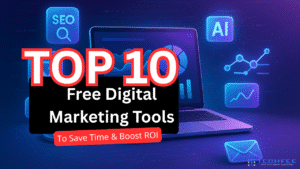Want to turn your passion into profit, share your voice with the world, or grow a personal brand that stands out online? It all begins with choosing the right blogging platform, or Best Blog Platforms — and trust us, it can make or break your blogging journey.
In 2025, blogging isn’t just about writing anymore. Whether you’re a beginner starting your first post, a writer craving creative freedom, a marketer aiming to drive traffic, or an online business owner wanting to turn blogs into sales, your platform decides how easily (and quickly) you grow.
But here’s the catch — with so many platforms claiming to be the “best,” how do you actually choose the one that fits your goals?
That’s exactly what this guide is about.
According to Optinmonster, in the US, there are approximately 31.7 million bloggers, with over 600 million blogs on the internet. Bloggers publish around 7.5 million posts daily, and over 77% of internet users read blogs. The average blog post is about 1,500 words long, and businesses leverage blogs for SEO, establishing authority, and customer engagement.
In this comprehensive post, you’ll discover:
- The 15 best blogging platforms for different needs
- Which platforms are best for SEO, writing, monetization, or combining a blog with a shop
- The pros, cons, and pricing of each platform (free and paid)
- Real tips to help you start, grow, and profit from your blog in 2025
So, if you’re ready to skip the guesswork and find the platform that empowers your voice and your income, keep reading.
The perfect blogging platform is just a few scrolls away.
What Makes a Blogging Platform the Best?

Choosing the best blogging platform in 2025 isn’t just about posting content — it’s about building an online presence that grows with you.
Whether your goal is writing, making money, starting a blog and shop, or boosting SEO, the right platform must support your ambitions, not limit them.
Let’s break down the most important factors that define a top-performing blogging platform today:
1. Ease of Use & Interface
When you’re starting out — or even managing multiple blogs — a platform’s user interface can make all the difference.
The best blogging platforms offer intuitive dashboards, drag-and-drop editors, and clean navigation that don’t require coding knowledge.
💡 Example: Platforms like Wix and Squarespace are loved by beginners for their visual editors, while WordPress.org offers a flexible but slightly steeper learning curve.
2. SEO Capabilities & Optimization Features
Without visibility, your blog can get lost in the noise. The best blogging platforms for SEO give you control over:
Meta titles & descriptions
Custom URLs
Schema markup
Image alt tags
Sitemaps and more
💡 Example: WordPress.org (paired with plugins like Yoast SEO or Rank Math) continues to dominate as the best SEO blogging platform. According to Ahrefs, over 43% of top-ranking blogs run on WordPress.
3. Customization & Design Flexibility
Your blog is your brand. Whether you’re a minimalist or want full control, customization is key. Top blog platforms offer:
Thousands of themes
CSS editing
Responsive design
Mobile optimization
Font and layout options
💡 Example: WordPress.org gives complete design freedom, while Squarespace is praised for its professionally designed templates out of the box.
4. Monetization Options (Ads, Affiliate, Products)
If you’re planning to make money from blogging, your platform must support:
Google AdSense integration
Affiliate marketing tools
Sponsored content setups
Memberships or paywalls
Digital product sales
💡 Example: Substack is ideal for paid newsletters, Shopify is best for blog + store, and WordPress.org supports all major ad and affiliate systems.
5. E-commerce Integration (Blog + Shop Platforms)
In 2025, many creators want to sell directly from their blog. If you plan to sell products (physical or digital), look for platforms that offer seamless e-commerce integration.
💡 Example: Shopify is purpose-built for combining blogs and shops. WordPress with WooCommerce is another flexible option.
6. Pricing & Free Plan Availability
Your budget matters. Fortunately, many free blogging platforms offer great starting points. But it’s important to know when (and what) you’ll need to pay for.
Key things to compare:
Free plan limitations (storage, bandwidth, domain)
Upgrade costs
Hidden fees (e.g., transaction fees)
💡 Example: Blogger and Medium are free to start. Wix and Weebly also offer free versions with ads.
7. Hosting, Speed & Security
Slow-loading blogs and downtime = lost visitors and poor SEO. Look for platforms that offer:
Reliable hosting with 99.9% uptime
Fast page load times
Built-in SSL certificates
Malware protection & backups
💡 Stat: Google recommends pages load under 2.5 seconds — any longer and bounce rates can increase by up to 32% (source: Google/SOASTA).
💡 Example: WordPress.org paired with hosts like Hostinger offers high performance.
8. Community, Plugins & Scalability
The blogging journey doesn’t stop at setup. A strong platform should allow you to grow — with plugins, developer support, and active user communities.
💡 Example: WordPress.org has over 59,000+ plugins, and one of the largest open-source communities. If you ever need a feature, there’s probably a plugin for it.
9. Analytics & Growth Tools
Data drives growth. Platforms with built-in or easy integration of analytics tools can help you understand:
Traffic sources
Audience behavior
Conversion performance
Keyword rankings
💡 Example: Ghost and WordPress easily integrate with Google Analytics, while HubSpot CMS comes with advanced marketing analytics built in.
10. Support & Documentation
Running into issues is inevitable — but the real test is how easily you can solve them. Look for:
24/7 customer support
Live chat or email help
Tutorials, forums, or video walkthroughs
💡 Example: HubSpot and Squarespace offer excellent support. WordPress.org depends more on community forums and third-party support.
The “best” blogging platform isn’t one-size-fits-all — it depends on what you want to achieve, your budget, and how you plan to grow. But with these 10 factors in mind, you’ll be able to choose a platform that supports not just blogging, but long-term success.
Top 15 Best Blog Platforms in 2025

Let’s dive into the top-performing blog platforms that cater to beginners, professional writers, marketers, and online business owners — whether your goal is to write, build a brand, or make money online.
1. WordPress.org – The #1 Choice for Full Control
Best for: Advanced bloggers, marketers, and business owners
Why it stands out: WordPress.org powers over 43% of all websites globally, making it the most popular blogging platform. It offers full control over SEO, design, monetization, and plugins.
Pros:
Complete customization
Thousands of free & premium themes
Supports all monetization methods (ads, affiliate, store)
Excellent for SEO (especially with plugins like Yoast/Rank Math)
Cons:Requires hosting
Slight learning curve
2. Wix – Drag & Drop Simplicity for All
Best for: Beginners, creators, small businesses
Why it stands out: Wix offers a visual website builder with over 900+ templates, ideal for those who want ease of use without coding.
Pros:
Beginner-friendly editor
Free plan available
Built-in SEO tools
E-commerce integration with Wix Stores
Cons:Less flexibility than WordPress
Limited blogging features compared to others
3. WordPress.com – Best for Beginners
Best for: Personal bloggers, hobbyists
Why it stands out: Hosted by Automattic, WordPress.com is a managed version of WordPress.org. Great for beginners who want to start blogging quickly.
Pros:
No setup required
Free plan available
Secure & hosted
Mobile-friendly themes
Cons:Limited monetization on free plan
Less control compared to WordPress.org
4. Shopify – Best for Blog + Online Store
Best for: E-commerce bloggers, product sellers
Why it stands out: Shopify isn’t a blog-first platform, but it offers excellent blog + store functionality — perfect for content-led e-commerce.
Pros:
Clean blogging interface
Seamless integration with store pages
Great for SEO and product marketing
Cons:Higher cost
Limited design flexibility for blogs
5. Medium – Ideal for Writers and Readers
Best for: Writers, journalists, thought leaders
Why it stands out: Medium emphasizes writing and storytelling. No design hassle — just focus on content and grow through the Medium community.
Pros:
Built-in audience
Great reading experience
Free to start
Cons:Limited monetization
No design or branding control
6. Squarespace – Best for Designers & Portfolios
Best for: Designers, photographers, entrepreneurs
Why it stands out: Known for its beautiful, mobile-optimized templates, Squarespace is ideal for visual-heavy blogs or brands that rely on aesthetics.
Pros:
All-in-one builder
Built-in marketing tools
E-commerce features
Cons:Limited plugin ecosystem
Slightly expensive
7. Blogger – Classic & Free Google Blogging Tool
Best for: Beginners on a budget
Why it stands out: Owned by Google, Blogger offers a totally free and simple platform for hobbyists or basic bloggers.
Pros:
Free hosting
Google AdSense support
Easy setup
Cons:Outdated interface
Minimal design options
8. Ghost – Powerful for Professional Writers
Best for: Publishers, professional bloggers, paid subscriptions
Why it stands out: Ghost is a modern, open-source blogging platform built specifically for publishers and writers with monetization in mind.
Pros:
Clean writing interface
Built-in membership & subscription tools
Super fast (Node.js backend)
Cons:Requires self-hosting or Ghost Pro
Limited design options
9. Weebly – Beginner-Friendly Website Builder
Best for: Beginners, small business owners
Why it stands out: Simple drag-and-drop functionality with basic blogging tools — now owned by Square, it also supports small stores.
Pros:
Easy to use
Free plan available
E-commerce support
Cons:Limited blogging features
Templates feel outdated
10. HubSpot CMS – For Marketers & Lead Generation
Best for: Businesses, B2B marketers
Why it stands out: HubSpot CMS offers content + CRM + marketing automation — perfect for building blogs that generate leads.
Pros:
Integrated marketing tools
Fast hosting
SEO and analytics built-in
Cons:Expensive for small bloggers
Learning curve for non-marketers
11. Hostinger Website Builder – All-in-One Starter
Best for: New bloggers, solopreneurs
Why it stands out: Hostinger Website Builder offers an AI-powered drag-and-drop solution with fast hosting and blog templates.
Pros:
Affordable pricing
Fast performance
Simple interface
Cons:Newer in the market
Fewer third-party integrations
12. LinkedIn Articles – Blogging for Professionals
Best for: Industry experts, consultants
Why it stands out: Publishing on LinkedIn gives instant visibility to professionals in your network, making it ideal for thought leadership.
Pros:
Built-in audience
Great for networking
Free to use
Cons:No website ownership
Limited format control
13. Substack – Best for Newsletter Blogging
Best for: Writers focusing on email-based content
Why it stands out: Substack combines blogging and newsletters in one — perfect for direct-to-audience communication and paid subscriptions.
Pros:
Easy email setup
Monetization via paid newsletters
Focused on writing
Cons:No website builder features
Dependent on email growth
14. Tumblr – Microblogging & Community Focused
Best for: Short-form bloggers, creatives, niche communities
Why it stands out: Tumblr is a hybrid platform — part blog, part social network — ideal for microblogging and visual posts.
Pros:
Easy to post
Strong community feel
Free
Cons:Less useful for long-form or SEO
Fewer monetization options
15. Network Solutions Website Builder – Budget-Friendly
Best for: Cost-conscious bloggers
Why it stands out: A no-frills, entry-level blog builder with basic tools for those who want a budget-friendly presence.
Pros:
Affordable
Hosting included
Simple templates
Cons:Limited blogging features
Less known brand
Comparison Table: Best Blogging Platforms (2025)
| Blogging Platform | SEO Support | Free Plan | Monetization | E-commerce | Best For | Monthly Pricing (USD) |
|---|---|---|---|---|---|---|
| WordPress.org | Excellent (with plugins) | No | Ads, Affiliate, Store | Via WooCommerce | Advanced users, SEO, full control | $4–$15 (Hosting only) |
| Wix | Good | Yes | Ads, Affiliate | Built-in | Beginners, creators | $0–$24 |
| WordPress.com | Moderate | Yes | Limited | No | Hobby bloggers | $0–$45 |
| Shopify | Good | No | Full Store, Ads | Built-in | Blog + Online Store | $29–$299 |
| Medium | Limited | Yes | Limited | No | Writers | $0–$5 |
| Squarespace | Good | No | Ads, Affiliate | Built-in | Designers, creatives | $16–$49 |
| Blogger | Basic | Yes | Ads | No | Beginners on a budget | $0 |
| Ghost | Excellent | No | Memberships, Subscriptions | No | Professional writers | $9–$25 |
| Weebly | Basic | Yes | Ads | Basic | Small businesses | $0–$26 |
| HubSpot CMS | Excellent | No | Advanced Marketing Tools | Built-in | Marketers, lead gen | $25–$400+ |
| Hostinger Builder | Good | Yes | Ads, Affiliate | Basic | Beginners, solopreneurs | $2.99–$11.99 |
| LinkedIn Articles | Basic | Yes | Limited | No | Professionals | $0 |
| Substack | Moderate | Yes | Subscriptions | No | Newsletter bloggers | $0–$10 |
| Tumblr | Limited | Yes | Limited | No | Microbloggers | $0 |
| Network Solutions Builder | Basic | No | Ads | Basic | Budget users | $6–$10 |
Best Blogging Platforms for Specific Needs
Not every blogging platform fits all purposes. Depending on whether you want to write thought leadership content, build a personal brand, sell products, or just start a hobby blog — the “best” platform will vary based on your goals.
Here’s a breakdown of the top blogging platforms based on specific use cases, so you can choose the one that best matches your needs in 2025:
For Writers: Medium, Ghost, WordPress
If your primary focus is writing long-form content, telling stories, or building authority through your words — these platforms are ideal:
Medium is built for readers and writers. It offers a minimalist interface, built-in audience, and clean reading experience. However, customization and monetization are limited.
Ghost is designed for professional writers who want to monetize their audience through memberships or subscriptions. It’s fast, SEO-friendly, and distraction-free.
WordPress.org gives writers complete control over their blog’s design, SEO, and monetization — perfect for those who want to grow their blog into a content brand.
📌 Real-time Insight: Medium is home to over 100 million monthly readers, while Ghost is used by top creators for paid newsletters and content hubs.
For Creators & Designers: Wix, Squarespace
If you value aesthetics, visual storytelling, and branding, then Wix and Squarespace are top picks.
Wix offers over 900+ designer templates, a drag-and-drop editor, animations, and visual flexibility — perfect for portfolios and visual blogs.
Squarespace is widely preferred by photographers, designers, and fashion bloggers due to its award-winning, mobile-responsive templates and high-quality typography.
📌 Stat: According to BuiltWith, Squarespace powers over 3.6 million websites globally, especially in creative industries.
For Marketers: HubSpot, WordPress.org
If you’re blogging to generate leads, grow traffic, and drive sales, these platforms provide conversion-driven blogging environments:
HubSpot CMS combines blogging with CRM, email marketing, lead capture forms, and automation — ideal for B2B and inbound marketing.
WordPress.org, when paired with plugins like Elementor, OptinMonster, and HubSpot, becomes a full-blown content marketing engine.
📌 Marketer’s Note: HubSpot users experience 2x higher lead conversion rates thanks to its built-in tracking and smart content delivery.
For Beginners: WordPress.com, Blogger, Weebly
New to blogging? These platforms are simple, user-friendly, and require little to no technical skills:
WordPress.com allows you to start a blog in minutes with zero setup or hosting costs.
Blogger, by Google, is free and very easy to use — perfect for personal or hobby bloggers.
Weebly, now under Square, combines drag-and-drop functionality with basic blogging and store features.
📌 Tip: All three options offer free plans, ideal for beginners testing the waters before committing.
For Monetization: WordPress.org, Shopify, Substack
If your main goal is to make money from blogging, here are the platforms that offer the most freedom and features:
WordPress.org supports ads, affiliate marketing, product sales, memberships, and courses — a full business platform.
Shopify is perfect for combining blogging and product sales. Great for content-led e-commerce businesses.
Substack is a rising star for paid newsletter blogging, allowing writers to earn via subscriptions with zero upfront cost.
📌 Fact: Substack creators have collectively earned over $300 million, and WordPress.org users dominate affiliate and ad-based earnings.
For Free Blogging: Blogger, Medium, WordPress.com
If you’re looking to start blogging without spending a dime, these platforms offer powerful free options:
Blogger is completely free with Google hosting and AdSense support.
Medium is free to publish and read (with limitations) and offers a premium partner program.
WordPress.com provides a free plan with essential features, including SSL, themes, and basic SEO.
📌 Reminder: Free plans come with limitations — such as ads, no custom domain, and reduced monetization control. However, they are excellent starting points.
Bonus: Pro Tips to Grow Your Blog Faster in 2025
Choosing the best platform is just the first step. To build a successful blog that ranks, earns, and grows consistently, you need to implement smart strategies from the very beginning.
Here are four pro-level tactics that separate casual bloggers from serious online entrepreneurs:
1. Use Powerful SEO Plugins and Tools
Search engine optimization (SEO) is the backbone of organic traffic. No matter which platform you choose, implementing proper on-page SEO from day one is essential.
💡 Top SEO tools and plugins:
WordPress.org: Use Rank Math or Yoast SEO to optimize titles, meta descriptions, XML sitemaps, image alt texts, and internal links.
Squarespace & Wix: Built-in SEO features include custom slugs, image compression, and mobile optimization. Use Ahrefs Webmaster Tools or Ubersuggest externally to audit your site.
HubSpot CMS: Includes advanced SEO suggestions, topic clustering, and real-time optimization guidance.
Use Google Search Console and Bing Webmaster Tools to monitor your keyword performance and indexing status.
📌 Data Insight: Blogs that actively implement SEO tools receive up to 126% more traffic than those that don’t (source: Backlinko, 2024).
2. Follow a Strategic Content Writing Framework
High-quality content still wins — but consistency, intent, and structure are everything in 2025.
💡 Effective content strategy tips:
Focus on search intent: Use tools like AnswerThePublic, Semrush, or Google Trends to understand what your audience is actually searching for.
Follow a pillar + cluster content model: Create one in-depth “pillar” guide (like this one) and link smaller, related “cluster” articles to it.
Use headings (H2/H3), bullet points, and internal links to increase readability and SEO performance.
Write for humans first, then optimize for Google — your content should answer real problems, not just stuff keywords.
📌 Fact: Long-form blog posts (1,500+ words) with structured headings and internal links have a 70% higher chance of ranking in Google’s top 10 (source: HubSpot, 2025).
3. Monetization Hacks That Actually Work
Once your blog has traffic, it’s time to turn those clicks into income. Smart monetization strategies go beyond ads.
💡 Effective monetization methods:
Use affiliate marketing with platforms like Amazon Associates, Impact, or ShareASale — add contextual links within content naturally.
Sell digital products (eBooks, templates, guides) using Gumroad or WooCommerce.
Offer consulting or coaching services directly from your blog with tools like Calendly and PayPal integration.
Join ad networks like Ezoic or Mediavine once your traffic grows past 10,000+ monthly visitors for higher revenue than AdSense.
📌 Monetization Trend: Bloggers focusing on niche-specific affiliate products have reported up to 3x higher earnings compared to those using display ads alone.
4. Build an Email List from Day One
Unlike social followers, your email list is your owned audience — and it’s crucial for building long-term relationships and consistent traffic.
💡 Email growth tips:
Use tools like ConvertKit, MailerLite, or Brevo (formerly Sendinblue) to create automated sign-up forms and welcome sequences.
Offer a lead magnet (like a checklist, mini eBook, or free course) in exchange for email sign-ups.
Add exit-intent popups, content upgrades, or embedded sign-up forms in your most popular blog posts.
Send weekly newsletters with value-packed tips, exclusive deals, or product recommendations using affiliate links.
📌 Data Insight: According to Campaign Monitor, bloggers who build an email list earn 2–3x more in affiliate revenue than those who don’t.
Final Verdict: Which Blogging Platform Should You Choose?
With so many options available, choosing the best blogging platform ultimately comes down to your personal goals, experience level, and long-term vision.
If you want full control, SEO power, and room to scale and monetize, go with WordPress.org — it’s the most flexible and future-proof platform.
If you’re just getting started and prefer a drag-and-drop experience, Wix or WordPress.com are excellent beginner-friendly choices.
For creatives and designers, Squarespace offers stunning visual templates that make your blog stand out.
Writers and storytellers will love Medium or Ghost, which offer distraction-free environments and reader-focused tools.
Looking to sell products and blog under one roof? Shopify is your all-in-one blog + e-commerce powerhouse.
And if you’re on a tight budget, Blogger, Substack, or Tumblr let you start blogging for free with minimal setup.
No matter your niche or experience level, there’s a platform tailored for you.
💡 Ready to take the first step? Start your blog today with the platform that fits your goals best — and build something amazing in 2025!
Frequently Asked Questions
What's the best platform to write a blog?
WordPress.org is the best platform for writing, SEO, and full customization.
Can you make $1000 a month blogging?
Yes, with consistent traffic and smart monetization (affiliate links, ads, products), many bloggers earn $1,000+ monthly.
What is the best platform to start a blog for free?
Blogger, WordPress.com, and Medium offer the best free blogging options.
How do I start a blog and what are the best blogging platforms available?
Choose a niche, select a platform like WordPress.org, set up hosting, pick a theme, and start writing valuable content.
Which is the best blogging platform for personal blogging?
WordPress.com and Medium are great for personal, hobby-style blogs.
What site do most bloggers use?
Most professional bloggers use WordPress.org for its flexibility and SEO power.
Which blogging platform is best for blogging?
WordPress.org is the best all-around blogging platform in 2025.
Can you use Shopify for blogging?
Yes, Shopify has a built-in blog feature suitable for content and product marketing.











